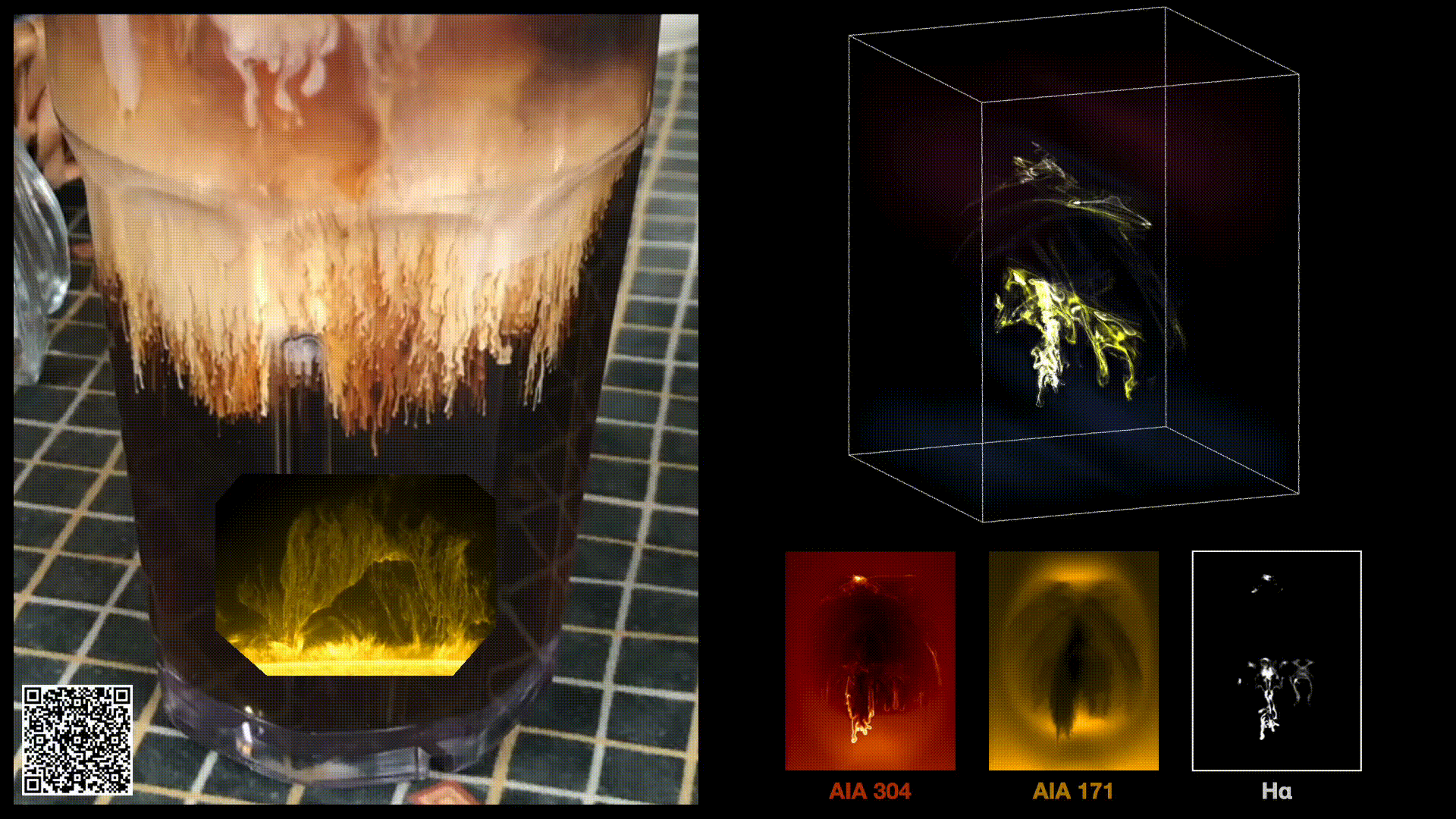We have recently published an article in Nature Astronomy that addressed a longstanding question for the difference in appearance between a solar prominence and a solar filament, an identical phenomenon given two names on account if their wildly differing appearances within the solar atmosphere. Some of the imagery from that publication is reproduced within the top image of this page. On the left-hand side, we have a picture showing the Rayleigh-Taylor instability ocurring within a cold cup of coffee - the link to the original video is shared with the QR code. Inset within the coffee, we have included a movie showing a famous observations of a prominence that is a part of the European Solar Telescope Gallery that can be found here along with many other beautiful examples of solar observations (https://est-east.eu/solar-gallery). On the right-hand side: top - volume rendering of the simulation cube showing the formed prominence; bottom-(left & centre) - the appearance of this simulated prominence in the 304 and 171 observing window of the Atmospheric Imaging Assembly instrument on board the Solar Dynamics Observatory, a solar observatory in Earth-orbit, respectively; bottom-right - the appearance of the simulated prominence in the ‘Hydrogen-Hα’ observing window used by the ground-based observatory network ‘GONG’.
Early observations of the Sun were only possible with the help of the Moon during solar eclipses - acting as a natural occulter, a total eclipse blocks almost all of the light from the solar disk and reveals to us, even today, the structures that are present within the outer atmosphere of the Sun: the solar corona. From these early observations, astronomers commonly remarked upon the presence of a bright red, cloud-like phenomenon that could be seen to protrude just above the edge of the occulting moon1. In fact, this phenomenon goes as far back as 1185 Novgorod when it was remarked ‘The Sun became like a crescent of the New Moon and from its horns a glow like a roasting fire was coming forth’ 2 following a resolution of the International Astronomical Union in 1938.}. And so the ‘Prominence’ became known to the human race. Some centuries later, following the invention of the spectroscope and spectroheliograph in 1868 and 1889, respectively, observations of the solar disk noted the presence of elongated, dark ‘filaments’ and it was soon after realised that these were the same as prominences, but viewed from a different angle. Since then, the study of prominences and filaments entered a truly golden age as the different observational technologies were increasingly improved upon so as to yield better and better views of this stellar phenomenon.
For the modern solar physicist, technology has advanced so far since those early days that we now have access to ginormous telescopes, both in space and on the ground, with unimaginably sensitive equipment in comparison. Some examples of these incredible phenomena have even made their way into beautiful collage movies that are freely available online3 As one may expect, we therefore know a great deal more now than we did then about the properties of the plasma within solar prominences and filaments. For example, how they form, what kinds of evolutions they can undergo, and the processes they may follow at their end of life. We can even track them as they evolve throughout the solar atmosphere, and ‘diagnose’ them routinely enough that we’re starting to form predictions as to how and when they may become unstable and erupt as solar coronal mass ejections.
A key principle is that plasma and magnetic field are intricately related, so much so that often the plasma is bound to flow in a direction imposed by the local magnetic field. Since plasma within the solar atmosphere adheres to this, we expect the plasma of filaments and prominences to flow in a direction governed by the shape of the magnetic field. Modern observations have revealed to us that the magnetic field of filaments and prominences is oriented horizontal to the solar surface. And so, we would expect to see plasma flows that agree with this and herein lies the problem: filaments agree but often times prominences do not. Prominences, quite curiously, show flows that are oriented vertically to the solar surface, that is completely perpendicular to, and across, the magnetic field - something that is prohibited altogether. Since we earlier mentioned how filaments and prominences are the exact same phenomenon, just viewed from different perspectives, why have we been unable to come up with an explanation for this paradox?
Finally, after many decades, we have an answer. The culmination of a decade of efforts aided by advances in computing power, has led researchers at KU Leuven to successfully construct the most realistic representation of a solar prominence/filament to date. This may be regarded as an already impressive feat on its own given the computational resources required. Upon inspection of this simulation, however, we found that the vertical flows remarked upon in observations had self-consistently generated themselves. In principle, this means that by assuming the model to accurately represent the atmospheric conditions of solar filaments and prominences, the process by which these structures generated themselves is truly identical to those processes occurring within the actual solar atmosphere.
The beauty of the results that we find within our simulation is that the answer was staring us in the face the whole time. The ‘Rayleigh-Taylor instability’, the mechanism that we find to be responsible for this observational paradox that solar prominences presented us with, is a specific flavour of another process believed to occur throughout the universe - even here on Earth. Many of us will be able to recall from high school science class that a dense fluid falls compared to a less-dense fluid, and you can see this process happening in your own coffee cup (insert the milk slowly on top, and use a transparent glass, of course) and this represents the core of the behaviour described by the ‘RTI’ process. However, I mentioned before that the solar atmosphere contains magnetic fields and plasmas and that implies important differences in the RTI mixing seen here on Earth, like between water and oil. In fact, it was shown almost 60 years ago by a famous physicist, Dr. Chandrasekhar, that although the picture is more complicated, there are conditions where the behaviour can be considered almost identical. And it is under exactly these simplified conditions that we find the prominence plasma within our simulations to behave: the dense, heavy plasma of a solar prominence is capable of dragging the magnetic field in a vertical direction without violating the intricate coupling between flows and magnetic field lines.
But why do we care, and why should anyone for that matter? For us, as scientists, we’re curious about how the natural world around us operates and so first and foremost it is extremely satisfying to have an answer to what could be considered at least a 50 year, perhaps even century old question. One of the beauties of ‘laws of physics’ is that you often don’t have to look too hard to find examples of these universal processes closer to home. This is exactly what we have been able to show with our work - processes that we have seen to occur within planetary nebulae, supernovae, nebulae, etc. also happen within the solar atmosphere, and the best part is that it’s happening only 150 million kilometers away - you’ll have to trust me when I say that’s close on galactic scales. With the extensive array of existing telescopes at our disposal we are already in a fantastic position to study processes that occur throughout the universe, but even more so with upcoming solar telescopes of Solar Orbiter and DKIST that promise to give us unprecedented views of these same processes within the atmosphere of our nearest star.
The paper reporting these results can be found at https://www.nature.com/ and with open access, but no saveability, at: https://rdcu.be/

